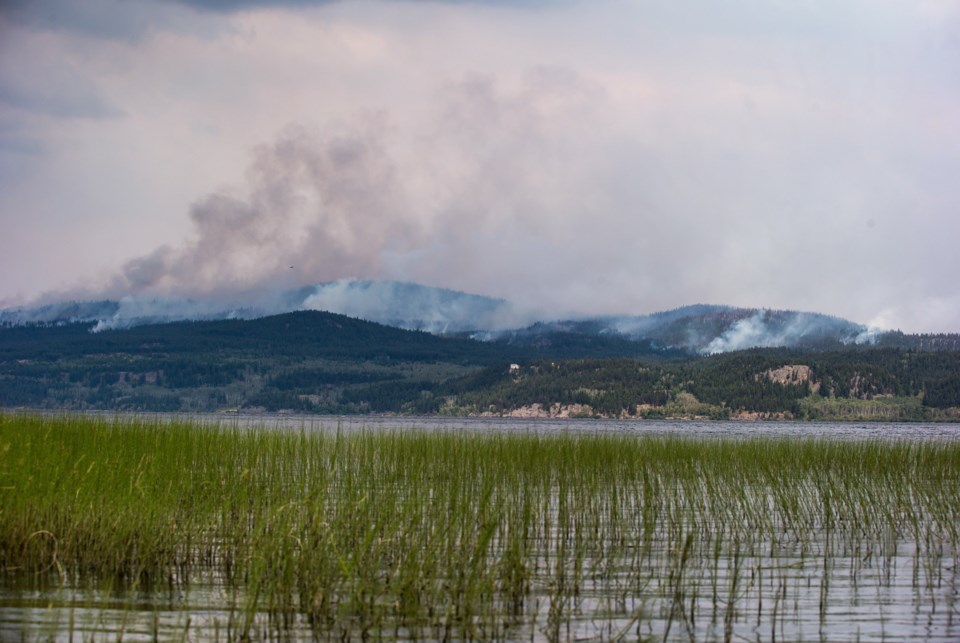More than 790,000 hectares of forests in B.C. have burned so far this year. Last year, 1.2 million hectares burned.
Floods in the Interior followed the 2017 fire season.
The connections between forests, fire and floods are clear, but we’re now beginning to understand that the kind of intense wildfires we’ve been seeing threaten far more less-obvious resources.
Forests absorb rainwater, ration snowmelt into streams, reduce erosion, and help to control seasonal and extreme-weather flooding. They store carbon and nutrients, absorb dust and pollution, and clean the air. They increase biodiversity that helps to control pests.
They also are critical for water quality.
Most British Columbia communities rely on water from the province’s forests. Forests surround and protect drinking-water reservoirs. Forest soils filter precipitation that feeds aquifers and wells that communities draw from.
But the large, intense wildfires that B.C. has seen over the past few years are putting that taken-for-granted water quality at risk.
When forests are burned intensely and extensively, a landscape’s relationship with precipitation changes. Trees soften the impact of rain or hail on the ground. They shade snow-covered ground, slowing melt. Their roots and discarded leaves and needles create soil that readily absorbs and stores water.
These services reduce erosion, slow the release of water into creeks and rivers, and help dampen the extremes of seasonal and extreme weather-event flooding.
A series of studies from about 10 years ago examined how the province’s mountain pine beetle epidemic affected the Fraser River Basin. The Fraser collects runoff from across 240,000 square kilometres of central and south B.C. — much of that territory home to the beetle epidemic. The beetle killed millions of trees in the Interior from 1995 to 2012.
Results from the watershed studies showed that the loss of healthy tree cover by the beetle would increase erosion, sediment loads and water temperatures along local streams and rivers. They also predicted a second, earlier spike in river levels on the lower Fraser to coincide with snow melt off lower-altitude beetle-damaged landscapes, in addition to the usual peak that comes with later snowmelt farther afield and higher up the mountain slopes.
Those studies focused primarily on flood potential caused by the beetle epidemic — itself made possible by decades of forest-fire suppression in B.C. The huge amounts of dead timber left on the landscape after the beetle outbreak add to the severity of Interior wildfires.
Because fire removes all vegetation from the hottest-burned areas, whereas insect infestations kill only specific species, high-intensity wildfire has more immediate and severe impacts on erosion. Researchers who spent the past 15 years tracking the effects of the massive 2003 Lost Creek fire in southern Alberta found that post-fire spring runoff begins earlier and is faster, increasing erosion and creating drier forests.
They also noted that the runoff flushes more nutrients — up to 19 times more — into streams and rivers. The extra nutrients trigger algae blooms downstream that limit which critters can survive in streams, rivers and lakes. The nutrients also boost microbe populations that can lead to boil-water advisories in communities and the need for increased chemical treatment and more infrastructure to ensure water is safe to drink. The nutrients can also react with treatment chemicals to form compounds that are themselves harmful.
The researchers traced those effects hundreds of kilometres downstream from burned areas, and found the effects lingered for years.
Implications for B.C. communities are huge. Costs to treat water rise, with taxes increasing to cover the costs of additional infrastructure and treatment. Communities that can’t afford adequate water treatment see population and tax bases stagnate or decrease. Public-health risks and associated costs also rise.
If we’re going to change how we manage our forests — to protect the full range of critical natural services they provide, including water quality — we have to start now. A forest takes a period equalling several human generations to mature. The conditions needed to support a widespread insect infestation need decades to emerge, and the infestation itself can take years to reach its peak.
But high-intensity fires need only a spark and a few hot, dry, windy weeks to decimate a forest. And the consequences can linger for years.



